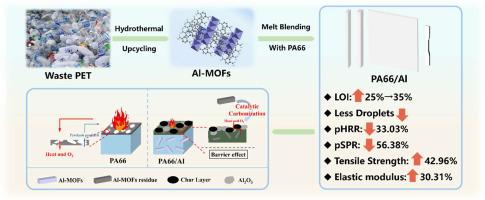Upcycling PET waste into Al-MOFs with one-step hydrothermal method and its application in flame retardant of PA66
IF 7.4
2区 化学
Q1 POLYMER SCIENCE
引用次数: 0
Abstract
We developed a sustainable closed-loop strategy to convert post-consumer PET waste into functional aluminum-based metal-organic frameworks (Al-MOFs) via a one-step hydrothermal method. This process uses PET-derived terephthalic acid as the organic linker. The resulting rod-like Al-MOFs (5–10 μm, MIL-53 structure) exhibit high thermal stability and were incorporated into polyamide 66 (PA66) as flame-retardant additives. At an optimal 4 wt% loading, the PA66/Al composite achieves a 40 % increase in limiting oxygen index (from 25 % to 35 %) and reduces peak heat release rate by 33.04 % (from 727.61 kW·m⁻² to 487.24 kW·m⁻²), while enhancing tensile strength by 19.74 % (from 57.42 MPa to 68.76 MPa). Mechanistic studies confirm that Al-MOFs function through a condensed-phase flame-retardant mechanism: catalytic carbonization promotes continuous char formation, evidenced by a 47.71 % increase in experimental char residue (4.895 %) over the theoretical value (3.314 %) under N₂. Concurrently, in situ-generated Al₂O₃ (XPS Al 2p at 74.6 eV) reinforces the char barrier, suppressing heat/oxygen transfer and volatile release. This effect further reduces peak smoke production rate by 56.38 % (0.1442 to 0.0629 m²·s⁻¹) and decreases CO/CO₂ evolution. The combined flame suppression and mechanical enhancement stem from interfacial interactions between Al-MOFs carboxyl groups and PA66 amide bonds. This work provides a scalable approach to transform plastic waste into high-performance polymer additives that simultaneously impart flame retardancy and reinforcement without compromising material properties.

一步水热法将PET废渣升级为Al-MOFs及其在PA66阻燃中的应用
我们开发了一种可持续的闭环策略,通过一步水热法将消费后的PET废物转化为功能性铝基金属有机框架(Al-MOFs)。该工艺使用pet衍生的对苯二甲酸作为有机连接剂。制备的棒状Al-MOFs (5-10 μm, MIL-53结构)具有较高的热稳定性,可作为阻燃添加剂加入聚酰胺66 (PA66)中。在最佳的4 wt%负荷下,PA66/Al复合材料的极限氧指数增加了40%(从25%到35%),峰值热释放率降低了33.04%(从727.61 kW·m⁻²到487.24 kW·m⁻²),同时抗拉强度提高了19.74%(从57.42 MPa到68.76 MPa)。机理研究证实了Al-MOFs是通过凝聚相阻燃机理起作用的:催化碳化促进了连续的焦渣形成,在N₂作用下,实验焦渣(4.895%)比理论值(3.314%)增加了47.71%。同时,原位生成的Al₂O₃(XPS Al 2p在74.6 eV)加强了炭垒,抑制了热/氧传递和挥发性释放。这一效应进一步降低了峰值产烟率56.38%(0.1442至0.0629 m²·s),并减少了CO/CO₂的发展。火焰抑制和机械增强的结合源于Al-MOFs羧基与PA66酰胺键之间的界面相互作用。这项工作提供了一种可扩展的方法,将塑料废物转化为高性能聚合物添加剂,同时赋予阻燃性和增强性,而不影响材料性能。
本文章由计算机程序翻译,如有差异,请以英文原文为准。
求助全文
约1分钟内获得全文
求助全文
来源期刊

Polymer Degradation and Stability
化学-高分子科学
CiteScore
10.10
自引率
10.20%
发文量
325
审稿时长
23 days
期刊介绍:
Polymer Degradation and Stability deals with the degradation reactions and their control which are a major preoccupation of practitioners of the many and diverse aspects of modern polymer technology.
Deteriorative reactions occur during processing, when polymers are subjected to heat, oxygen and mechanical stress, and during the useful life of the materials when oxygen and sunlight are the most important degradative agencies. In more specialised applications, degradation may be induced by high energy radiation, ozone, atmospheric pollutants, mechanical stress, biological action, hydrolysis and many other influences. The mechanisms of these reactions and stabilisation processes must be understood if the technology and application of polymers are to continue to advance. The reporting of investigations of this kind is therefore a major function of this journal.
However there are also new developments in polymer technology in which degradation processes find positive applications. For example, photodegradable plastics are now available, the recycling of polymeric products will become increasingly important, degradation and combustion studies are involved in the definition of the fire hazards which are associated with polymeric materials and the microelectronics industry is vitally dependent upon polymer degradation in the manufacture of its circuitry. Polymer properties may also be improved by processes like curing and grafting, the chemistry of which can be closely related to that which causes physical deterioration in other circumstances.
 求助内容:
求助内容: 应助结果提醒方式:
应助结果提醒方式:


